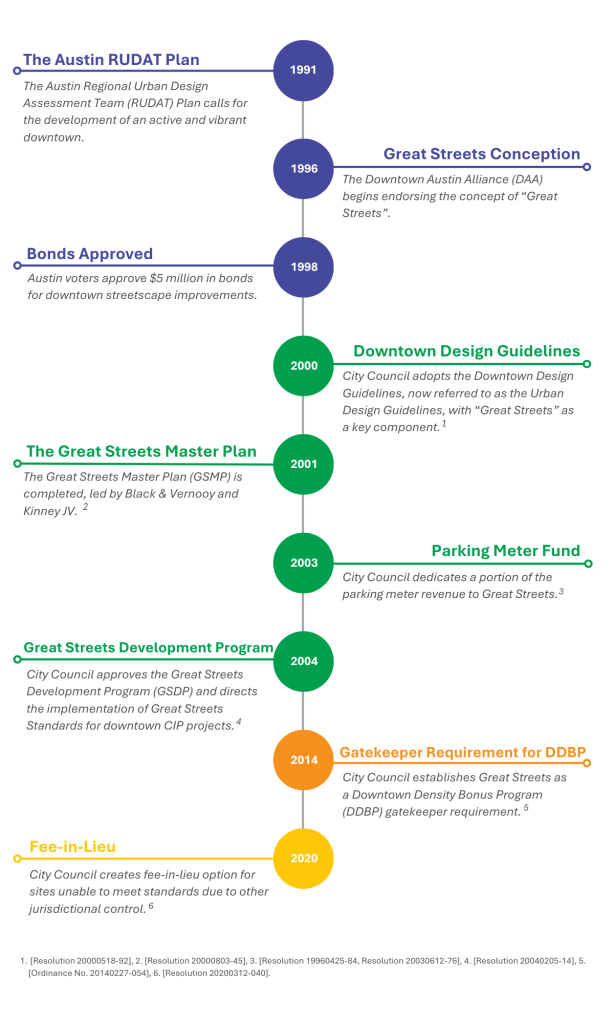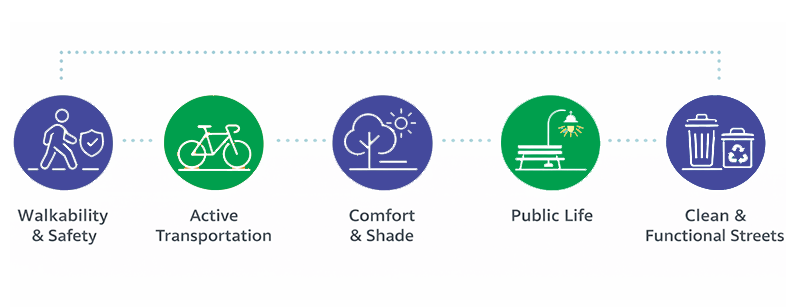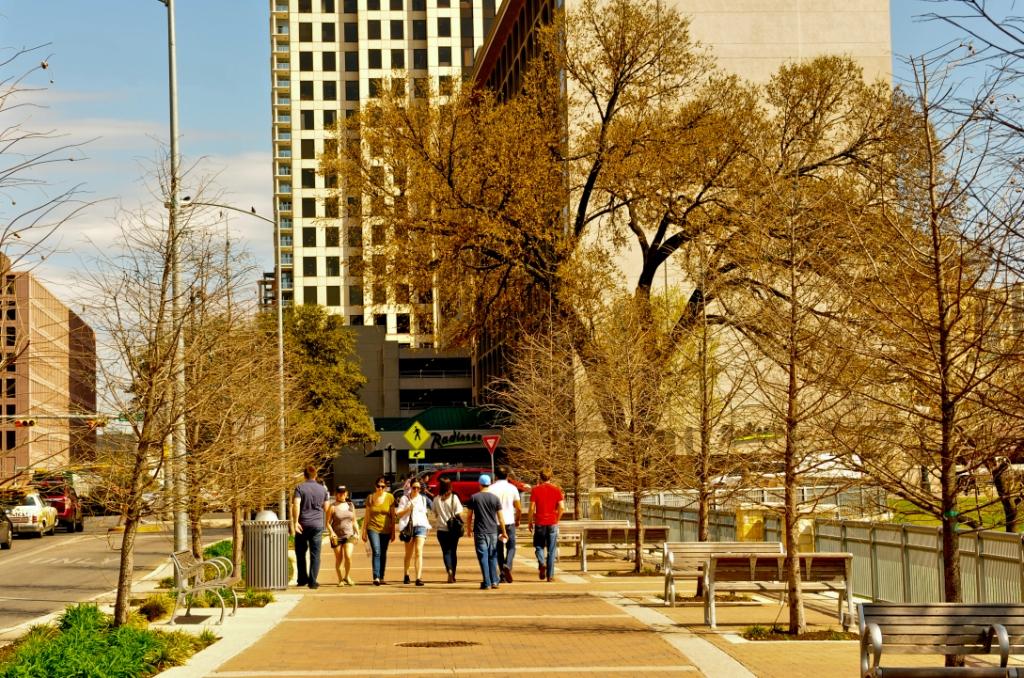The Great Streets Plan
The Great Streets Plan makes the Downtown pedestrian experience a place for interaction, urban life, vitality, and vibrancy in the heart of Austin.
The Great Streets Program aims to enhance the livability, safety, and aesthetics of Austin’s downtown streets by creating “streets for people” through the increased balance of space for pedestrians and the enhancement of streetscape standards.
"Streets for people in Downtown Austin"
Objectives
- The preliminary objectives guiding the update include:
- Focusing on the entirety of the downtown pedestrian experience
- Conducting holistic conversations around the entire right-of-way
- Highlighting the successes and contributions of Great Streets to downtown
- Modernizing and clarifying the standards
- Increasing flexibility and incorporating conflict-resolution guidance
- Aligning the program with other major city initiatives
- Ensuring continued and consistent funding and accountability
Great Streets Plan Update
The Great Streets Plan is being updated. For more information, visit the SpeakUp Austin page and watch the video below.
 Great Streets History
Great Streets History 
 Great Streets Boundaries
Great Streets Boundaries -
Great Streets Program
The sidewalks included in the Great Streets Program are bounded by East Martin Luther King Jr. Boulevard to the north, Cesar Chavez Street to the south, I-35 to the east, and Lamar Boulevard to the west. Two forms of Great Streets implementation, the Downtown Density Bonus Program areas and Capitol Improvement Projects, fall within these boundaries.
Great Streets Development Program
To be eligible for the Great Streets Development Program (GSDP), a reimbursement program between private and public partners, businesses must be within the boundary of 11th to the north, Cesar Chavez Street to the south, I-35 to the east, and Lamar Boulevard to the west.

 Benefits of Great Streets
Benefits of Great Streets-
We want Downtown to be a place Austinites feel great about – a place they want to live, work, and visit regularly. To achieve this vision, the Great Streets Program requires pedestrian and bicyclist enhancements such as a widened sidewalks, street trees, benches, bike racks, lighting, and trash/recycling receptacles.

 Implementation
Implementation-
To date, Great Streets improvements have been implemented along approximately 230 block faces in downtown Austin. Since 2003, the application of Great Streets has occurred in three ways:
- Downtown Density Bonus Program (DDBP)
- Great Streets Development Program (GSDP)
- City-sponsored capital improvements projects (CIP)
Downtown Density Bonus Program (DDBP)
The majority of Great Streets blocks in Downtown are developed through the Downtown Density Bonus Program. Great Streets is a gatekeeper requirement, meaning developers are required to create streetscape frontages accordance to Great Streets standards in exchange for increased density and entitlements.
To learn more about the Downtown Density Bonus Program, click on this link (DDBP Link).
Great Streets Development Program (GSDP)
The Great Streets Development Program (GSDP) is an incentive program that reimburses private developers for a portion of the costs associated with implementing Great Streets standards with their projects enhancing streetscape improvements, while increasing function, quality, and aesthetics.
In order to be eligible for reimbursement, projects must:
- Be within the program boundaries of 11th Street to the north, Cesar Chavez Street to the south, I-35 to the east, and Lamar Boulevard to the west.
- Not be a part of the Downtown Density Bonus Program.
Once eligible reimbursement is established based on the project’s location on high, medium, or low pedestrian corridors. See this link for more information (GSDP Info Packet)
City Capital Improvement Project (CIP)
Capitol Improvement Projects are City-initiated. City Capital Improvement Projects (CIP), the Urban Design Division can participate in collaborations with internal and external stakeholders to advocate for Great Streets in public projects.
 Funding
Funding-
Funding for Great Streets is generated through the Great Streets Parking Meter Fund.
Great Streets Parking Meter Fund
- Established in 2003, the fund sets aside 30 percent of the revenues collected from downtown parking meters within the program’s boundaries.
- The fund generates approximately $728,000 per year and is the primary source of on-going funds for Great Streets.
- These funds are used to supplement City Capitol Improvement Projects (CIP) and the private-public partnership for Great Streets Development Program (GSDP) projects.
Project Examples
.png) Second Street
Second Street -
The Second Street Retail District is a pedestrian-oriented street where all building frontages are required to have active ground floor uses and a unique 32-foot-wide sidewalk on the north side allows for generous sidewalk cafes.

.png) Caesar Chavez Street
Caesar Chavez Street-
Conversion of Cesar Chavez Street a major east-west boulevard in the heart of downtown Austin, to a two-way boulevard bordered by a 32-foot wide pedestrian promenade with trees, furnishings, and other urban design elements overlooking the banks of Lady Bird Lake.

More Information
- Frequently Asked Questions
-
Q. How does the Great Streets Program align with Austin’s overall planning goals and initiatives?
A. The Great Streets Program aligns with the multiple initiatives and overall planning goals for the City of Austin by focusing on urban mobility and promotion of a vibrant, pedestrian-friendly downtown. These aims align with and support the City’s Austin Strategic Mobility Plan (ASMP) objectives, as well as complements the Imagine Austin Comprehensive Plan by fostering sustainable development and improving the public realm to create a more connected and livable city. Additionally, Great Streets supports the Downtown Austin Plan by revitalizing key corridors, thereby reinforcing the City’s commitment to creating a dynamic and economically thriving urban core.
Q. What types of improvements are made under the Great Streets program?
A. The Great Streets Program guides the design of pedestrian-friendly streetscapes for new projects downtown, beginning with widening of sidewalks and the pedestrian right of way (ROW) to allow for greater streetscape design and enhancements. Streetscape elements include, but are not limited to, street trees, light poles, trash and recycling receptacles, bicycle racks, and public art pieces, among others. Additionally, the program pursues diverse-mode transportation models prioritizing pedestrian oriented transit as well as improvements such as bicycle lanes.
Q. How does the Great Streets Program impact local businesses?
A. Through enhancement of street environments to become more pedestrian focused and increasing pedestrian foot traffic through people-centric urban design, the program aims to boost local business viability and attract more customers to downtown areas.
Q. Who can I contact for more information about specific projects or the overall Great Streets program?
A. Information about current and future projects can be found on the City of Austin’s website, through local government announcements, or by contacting the City’s Urban Design Division.
- Technical Resources
-
For more information on Great Streets standards, please reference the following:
For more information on Great Streets programming, please reference the following:
- Related Links

